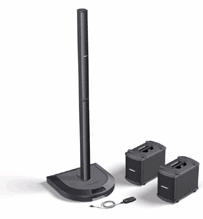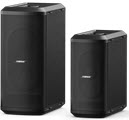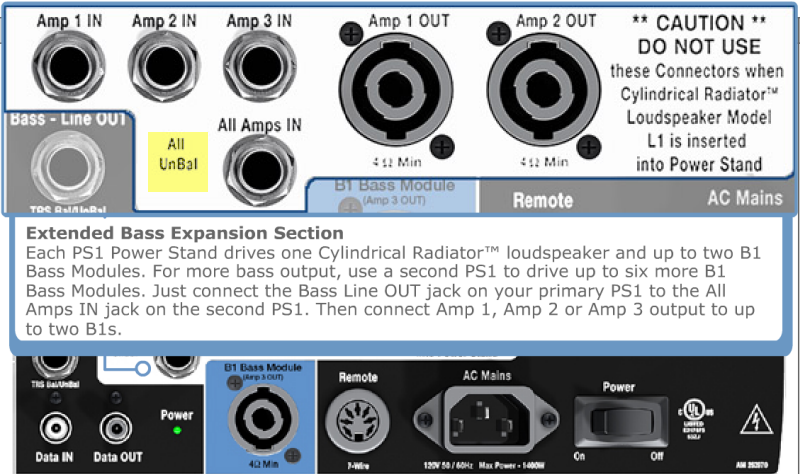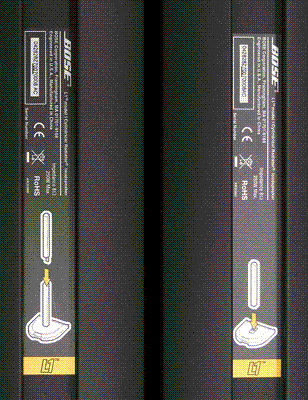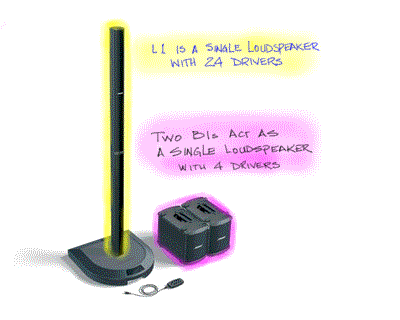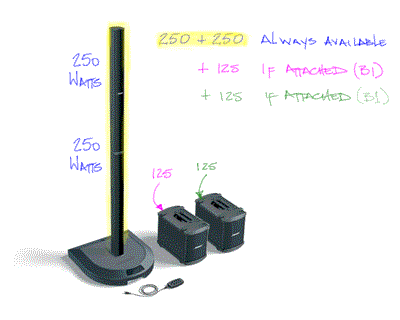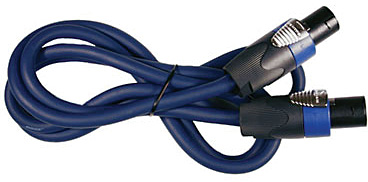L1® Classic
Contents |
Documentation |
How to Tell the Difference Between Bose Portable PA Models
This is how to tell which L1®, S1 Pro, or F1 unit you have.
| 2023 - Present | S1 Pro+ (optional wireless transmitters), Remote Control and ToneMatch Presets with Bose App | |||
| 2020 - Present | L1 Pro8, L1 Pro16, L1 Pro32, Remote Control and ToneMatch Presets with Bose App | |||
| 2020 - Present | Sub module for L1 Pro32 | |||
| 2018 - Present | 4 channel ToneMatch Mixer (stereo) | |||
| 2018 - Present | 8 channel ToneMatch Mixer (stereo) | |||
| 2015 - Present | Flexible Array Loudspeaker and Subwoofer | |||
| 2003 - 2007 | Rounded front. The Output Panel has Amp1 Out, Amp2 Out, Amp3 Out | |||
| 2003 - 2020 | Up to two per Power Stand (above). More if using the PackLite® power amplifier model A1. 2 x 5.25" drivers, 26.6 lb | |||
| 2005 - 2020 | Allows bass expansion for L1 Classic L1 Model I L1 Model II (not L1 Compact not L1 Model 1S) | |||
| 2007 - 2012 | Rounded front. The Output Panel has no outputs for Amp1, Amp2, Amp3. The Output Panel and L1 Cylindrical Radiator® loudspeaker sections have orange L1® markers. |
|||
| 2007 - 2020 | Extending legs, two Cylindrical Radiator®s, Bass Line Out, | |||
| 2007 - 2018 | T1 ToneMatch Audio Engine | |||
| 2009 - 2021 | Integrated Power Stand and Bass Unit, two Extensions | |||
| 2012 - 2020 | Extending legs, one Cylindrical Radiator® (Top Array), Bottom Extension | |||
| 2012 - 2020 | Up to one per Power Stand (above). More if using the PackLite® power amplifier model A1. 2 x 10" drivers 45 lb. Three position Bass Level switch. | |||
| 2018 - 2023 | Extremely Portable PA Battery powered | |||
Introduction
L1 Classic is the name now used to describe the first L1 Cylindrical Radiator® loudspeaker introduced in the United States, in October 2003.
The Classic remained in production until 2007 when it was replaced by the L1 Model I.
Visually and acoustically the L1 Classic is almost identical to the Model I, with only a few notable differences.
The serial number for any Classic tower should start with 032495 [1].
Comparison of the Classic to the Model I
Acoustical Output
The maximum output volume of the L1 Classic, the L1 Model I, and the L1 Model II are virtually identical.
In the L1 Classic, the L1 Cylindrical Radiator® loudspeaker is powered by two (2) 250 Watt amplifiers. In the Model I and Model II, the L1 Cylindrical Radiator® loudspeaker is powered by one (1) 250 Watt amplifier. The Classic, the Model I, and the Model II all use a second 250 Watt amplifier to power one or two B1 bass modules (update: or a single B2 Bass Module).
Although these numbers serve as a point of reference they do not tell the whole story. During the design of the L1 Model I and the L1 Model II the impedance of the L1 Cylindrical Radiator® loudspeaker was lowered. As a result of the lower impedance, a single 250W amplifier now powers the system to within 1.75 dB of the max SPL of the L1 Classic. Several other changes were made to the signal processing and acoustical sections to further reduce this small difference. Particular attention was paid to this change and many A/B comparisons were conducted by Bose to confirm that there was no significant audible difference between the two systems.
— Source: Ken-at-Bose, Neil-at-Bose
Power Stand Connections
L1 Classic shipped between 2003 and 2005
The L1 Classic had features built into its input/output panel that allowed the three amplifiers to be used separately as power amplifiers. For example, up to six B1 Bass Modules could be driven from an auxiliary Power Stand. See: Classic Extended Bass Package
The input/output panel as it appeared in units shipped between 2003 and 2005 is shown.
(Units that look like this were shipped with Presets 1.0 installed. An upgrade to Presets Version 2.0 is available and highly recommended.)
- On the right side of the input/output panel, there are inputs for
- All Amps In
- Amp 1 In
- Amp 2 In
- Amp 3 In
- And outputs for
- Amp 1 Out
- Amp 2 Out
- Amp 3 Out (used for B1 Bass Modules)
L1 Classic shipped between 2006 and 2007
Units that shipped between 2005 and 2007 were shipped with the Version 2 Presets. The input/output panel of these later units have a blue ring around the Amp 3 output (for B1 Bass Modules).
Detailed View of Input / Output Panel for 3 Amps
Note: All white inputs are unbalanced (Amp 1, Amp 2, Amp 3 ,All Amps In)
Model I
The L1 Model I uses a simpler input/output panel
- Dropped Amp 1 out, Amp 2 output found on the L1 Classic
- Identified by orange labels and L1® logo
- RoHS compliant.
- Shipped with Presets 3.0 installed.
L1 Model I Orange Markings
The L1 Model I has orange L1® Markings on the Power Stand and the L1 Cylindrical Radiator® loudspeaker sections. The other Models do not have these.
Power Stand
L1 Cylindrical Radiator® loudspeaker sections
Downloads for the L1 Classic
- Version 3.0 Presets Read instructions carefully.
- Version 2.0 Presets and Firmware Updates (bundled into one download)
Lower Section Only
Q: Can I run with only the lower section of the L1 Cylindrical Radiator® loudspeaker?
A: From a technical standpoint it is safe to operate the system with only the lower section of the L1® Classic , however the spatial and spectral performance of will be greatly reduced, so this has only a very limited application. - Hilmar-at-Bose[2]
Correcting the Tone
Try inserting a ¼ inch connector in the Bass Line Out of the Power Stand. This will cause the internal logic to reduce the Bass output, and this should give you a better overall tonal balance when running with only one section of the L1® Classic.
For very detailed notes about this see Half Stack.
Holistic View
A Holistic View of the L1® [3]
The L1 System (Physical)
Here is one way you can think about the L1 System.
L1 Cylindrical Radiator® loudspeaker as one loudspeaker
Think of the L1 Cylindrical Radiator® loudspeaker (Yellow highlight) is a single loudspeaker with 24 drivers (2.5 inch)[4] supplied by 500 watts for the L1 Classic and 250 watts for the L1 Model I. Note: the L1 Model I provides the same audible output. It is just more efficient than the L1 Classic.
Two B1 Bass Modules as one bass loudspeaker
Think of the pair of B1 Bass Modules (Purple highlight) is a single bass loudspeaker with 4 (6.5 inch)[4] drivers supplied by 250 watts. [5]
That's 750 watts in total for the L1 Classic and 500 watts total for the L1 Model I
The L1 System (Amplifiers & Power)
Note: This information below is applicable to the L1 Classic and not the L1 Model I
L1 Cylindrical Radiator® loudspeaker
The L1 Cylindrical Radiator® loudspeaker This is one loudspeaker that happens to break down into two pieces for travel. This is driven by two separate amps, but this is not important because under normal circumstances both amps are driven identically. One drives the top half of the L1 Cylindrical Radiator® loudspeaker and the other drives the bottom half. Because the L1 Cylindrical Radiator® loudspeaker should always be operated as a single unit, what happens when you break it down isn't relevant.
B1 Bass Modules
If you break the pair of B1 Bass Modules in half, and use just one of them, it draws 125 watts.[6]
If you don't use the B1 Bass Modules at all, the amp that is normally used to drive them is idle.
Use the proper cables
Warning - Use Blue B1 Cables NL4 cables with your L1 Classic / L1 Model I / L1 Model 1S L1 Model II
If you are using a B1 Bass Module with your Power Stand it is ESSENTIAL for proper operation that you use the BLUE cable supplied with the B1 Bass Module or B2 Bass Module. This is required so that the L1 Classic/L1 Model I/L1 Model 1S/L1 Model II Power Stand can correctly identify when there are bass modules connected to it and if so, how many.
Please click the picture above for ordering information.
- Note
- The B2 Bass Level Switch will not change the sound of the B2 Bass Module if you are not using the correct cable.
See: PS1 Power Stand / Bass Line Out for details about how the Power Stand adapts to the number of bass modules are connected to it.
You may also use high quality NL4 cables (four conductor cables).
Alternate and longer cables for B1s
Model I
The L1 Model I handles the B1s the same way, but with a more efficient design provides the same audible output from the L1 Cylindrical Radiator® loudspeaker with a single 250 watt amp.
- ↑ The serial number for any Classic tower should start with 032495. Nick-at-Bose
- ↑ Hilmar-at-Bose talks about using the lower half (only) of the L1® Cylindrical Radiator in the Bose® Musicians Community Message Boards
- ↑ Originally appeared in the Bose® Pro Portable PA Community
- ↑ 4.0 4.1 Quoting Hilmar-at-Bose
- ↑ two B1 Bass Module loudspeakers connected draws up to 250 watts at 4 ohms
- ↑ one B1 Bass Module loudspeaker connected draws up to 125 watts at 8 ohms
Compatibility with Other Members of the L1® Family of Products
Cylindrical Radiator®s
Cylindrical Radiator®s are not interchangeable across models
Specifically (and without exception)
- The Cylindrical Radiator speaker sections of the L1 Classic, the L1 Model I and L1 Model 1S and the L1 Model II are not compatible with each other.
- The Cylindrical Radiator speaker sections of the L1 Classic can only be used with the Classic PS1 power stand (no orange markings on the input/output panel).
- The Cylindrical Radiator speaker sections of the L1 Model I (orange markings on the back of both sections) can only be used with the Model I PS1 power stand (orange markings on the input/output panel).
- The Cylindrical Radiator speaker sections of the L1 Model II can only be used with the L1 Model II power stand.
- The Cylindrical Radiator speaker sections of the L1 Model 1S can only be used with the L1 Model 1S power stand.
T1 ToneMatch® Audio Engine, T4S/T8S ToneMatch® Mixers
- The ToneMatch mixers can be used with the
PackLite® power amplifier Model A1
- The PackLite® power amplifier model A1 can be used with
B1 Bass Module
- The B1 Bass Module can be used with the
B2 Bass Module
- The B2 Bass Module can be used with the
- L1 Classic Normal Mode only
- L1 Model I Normal Mode only
- L1 Model 1S all modes
- L1 Model II all modes but L1® Model II Power Stand Firmware version 1.4 or later required
